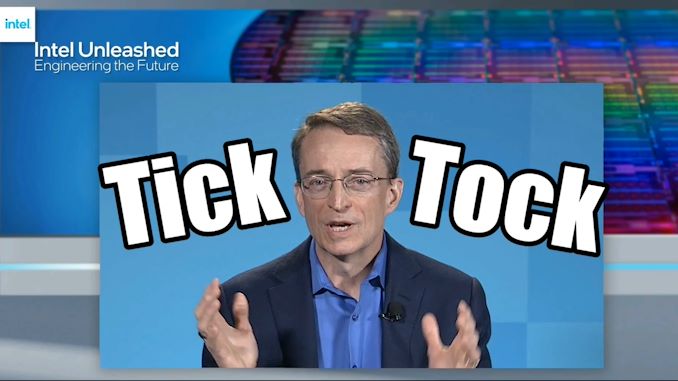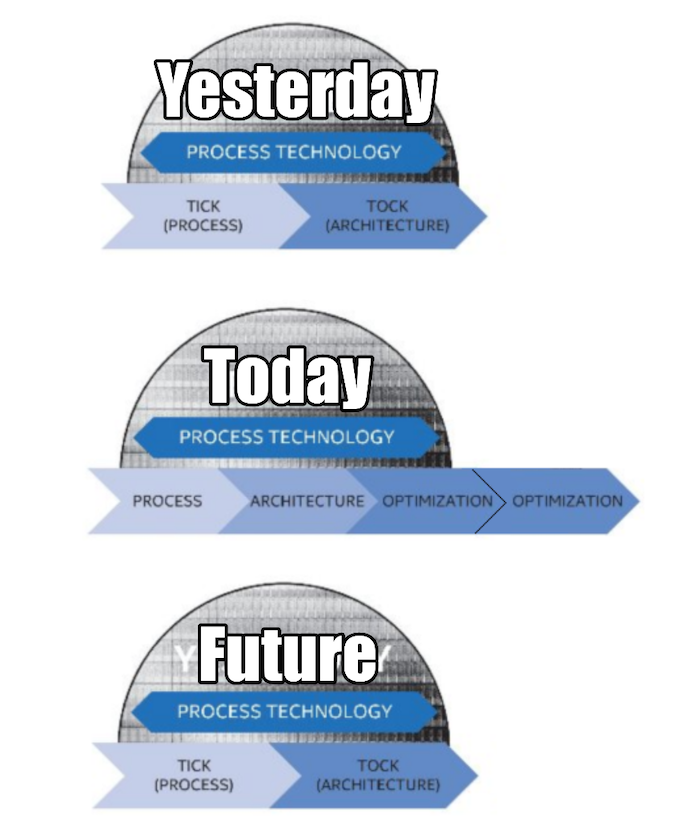Intel to Revive ‘Tick-Tock’ Model, Unquestioned CPU Leadership Performance in 2024/2025
by Dr. Ian Cutress on March 23, 2021 6:31 PM EST- Posted in
- CPUs
- Intel
- Tick-Tock
- 7nm
- Chiplets
- Pat Gelsinger
- Meteor Lake
- Tiles

As part of today’s announcements, during Intel’s Q&A session after the prepared remarks, CEO Pat Gelsinger explained how Intel is going to revive its fortunes when it comes to its leading edge compute products. One of Gelsinger’s mantras seems to be that unquestioned leadership products bring unquestioned leadership margins for those products, and for Intel to execute, it needs to return to its days of old.
In the past, through the 1990s, 2000s, and into the 2010s, Intel’s manufacturing philosophy was known as ‘Tick-Tock’. This means that for every product generation, the leading edge compute hardware was either a Tick (process node enhancement), or a Tock (microarchitecture enhancement). Each generation would alternate between the two, allowing Intel to take advantage of a familiar design on a new process node, or using a mature node to enable a new performance-focused design. That policy was scuppered when delays to Intel’s 10nm forced Intel into more of a Tick-Tock-Optimization-Optimization-Optimization model.
Today CEO Pat Gelsinger stated that at Intel’s core it has to re-establish the Tick-Tock model that enabled repeated leadership in the CPU ecosystem, buoyed by a healthy CPU roadmap. Part of this is re-establishing discipline in Intel’s ranks to continually provide both microarchitecture updates and process node updates on a regular expected cadence. Pat stated as part of the call that Intel will look towards a confirmed yearly process node improvement, and as a result, there might be a lot of Ticks in the future, with a push to more Tocks as well.
On top of this commentary, Pat Gelsinger also stated that Intel’s CPU roadmaps are already baked in through 2021, 2022, and 2023. The company is thus looking to 2024/2025 for ‘unquestioned CPU leadership performance’, which traditionally means the fastest processor for single thread and multi-thread workloads. This is for sure a laudable goal, however Intel will also have to adapt to a changing landscape of chiplet processor designs (coming in 2023), enhancing on-die accelerators (GNA already present), and also what it means to have leadership performance – in the modern era, leadership performance doesn’t mean much if you’re also pushing lots of Watts. Intel stated that its 7nm process is now comfortably on track to deliver Meteor Lake, a client CPU using tiles/chiplets, in 2023, however we are likely looking to a 7nm variant or even external processes for a 2024/2025 product. Intel has also stated that it is looking to consider the core of its leading edge compute on external foundry processes, although one might argue that this doesn’t explicitly say ‘CPU’.
It is also worth noting that Intel/Gelsinger isn’t calling its disaggregated silicon as ‘chiplets’, and prefers to use the term ‘tiles’. This is because Intel’s tiles amount to long wires across 3D packaging technologies like EMIB and Foveros, compared to package-based multi-die interconnect that require buffers as well as control fabric. Tiles by this definition are more costly to implement than chiplets, and have additional thermal considerations by having high-powered silicon close together, so it will be interesting to see how Intel balances these new packaging technologies with the more cost-sensitive elements of its portfolio, such as client processors.
It’s been known that Intel’s microarchitecture teams haven’t been idle waiting for 10nm to come through the pipe, with a number of designs ready and waiting to go for when the process node technology matures. With any luck, if Intel can get a headwind with 7nm, when 2024 rolls around it might all come thick and fast.











109 Comments
View All Comments
DigitalFreak - Tuesday, March 23, 2021 - link
Oh child. You have much to learn.Qasar - Tuesday, March 23, 2021 - link
nope, timecrap1818, just loves intel, and hates everything elseGeoffreyA - Wednesday, March 24, 2021 - link
Go on, stick with quality Intel.Otritus - Wednesday, March 24, 2021 - link
How is AMD "Chinese-built"? The company is an American company who designs their microarchitectures in America. Their foundry is TSMC, a Taiwanese company, with fabs in Taiwan and America. Also, right now AMD is "quality" given that they are more performant, less power hungry, and more feature rich.Bagheera - Friday, March 26, 2021 - link
1) weed is good for you. may be try it sometime so you are not so angry all the time.2) TSMC is Taiwanese, not Chinese. please educate yourself on the difference.
3) "quality" Intel? is that why Intel cancelled their overclocking warranty? are Apple and Qualcomm silicon not "quality" because TSMC also makes those?
Oxford Guy - Wednesday, March 31, 2021 - link
'TSMC is Taiwanese, not Chinese. please educate yourself on the difference.'The people of Hong Kong say hello.
Spunjji - Friday, March 26, 2021 - link
Someone's salty that TSMC are at least 1.5 fab generations ahead of Intel 😬Trenteth - Tuesday, March 30, 2021 - link
Totally Agree Techie2, all my many compute devices are all ether AMD silicon or Apple silicon currently. My last 6 PC's built for me, my wife and my HTPC are all Ryzen and my wife has a Ryzen Laptop as well. AIso just got an M1 Mac for myself which is really good. not an Intel CPU in sight.inighthawki - Tuesday, March 23, 2021 - link
They forgot a few of the "Optimization"s in the picture.Hifihedgehog - Tuesday, March 23, 2021 - link
TODAYProcess (Broadwell) -> Architecture (Skylake) -> Optimization (Kaby Lake) -> Optimization (Coffee Lake) -> Optimization (Whiskey Lake) -> Optimization (Comet Lake) -> Last-Ditch Effort (Rocket Lake)